
Gates
Foundation to Fund Anti-Malarial Research
Year in Review at Berkeley
Lab
Foundation to Fund Anti-Malarial Research
The Synthetic Biology Depart-ment, created in 2003 by Graham Fleming, director of Berkeley Lab’s Physical Biosciences Division (PBD), is already reaping benefits. Research led by PBD chemical engineer Jay Keasling, who heads the department, resulted in the creation of a simple and much less expensive means of making one of the most promising and potent of all the new anti-malarial drugs. This, in turn, has led to an announcement from the Bill & Melinda Gates Foundation of a $42.6 million grant to take Keasling’s development to the production level. The ultimate payoff will be an affordable, accessible cure for malaria, a disease that kills more than a million children each year.
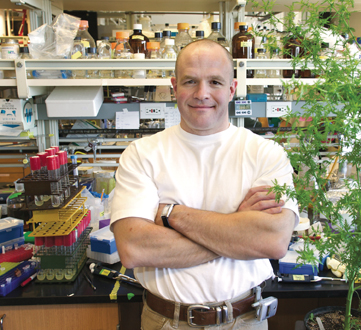 Jay Keasling’s research led to the development of a less expensive
anti-malarial drug, to be produced and distributed thanks to a $42.6
million grant from the Gates Foundation.
Jay Keasling’s research led to the development of a less expensive
anti-malarial drug, to be produced and distributed thanks to a $42.6
million grant from the Gates Foundation.
“The new field of synthetic biology has the potential to provide solutions to some of humankind’s most pressing problems,” Fleming said in response to the Gates Foundation announcement. “I applaud Bill and Melinda Gates’ vision in enabling Jay Keasling to convert this potential to a reality in the treatment of malaria, one of the greatest sources of misery on earth. Their generosity will galvanize synthetic biology, whose development will lead to a fundamental new understanding of cellular function, as well as a host of significant applications.”
Under the terms of the Gates Foundation grant, announced on December 13, the money will be distributed through the Institute for OneWorld Health, the first nonprofit pharmaceutical company in the United States. Some of this money will support continued research by Keasling — also a professor of chemical engineering at UC Berkeley and an affiliate of the California Institute for Quantitative Biomedical Research (QB3) — to perfect his technique for producing the anti-malarial super drug, artemisinin. This process will then be adapted for mass production by Amyris Biotechnologies, a new biotech company based in Albany, which was founded on the breakthroughs in synthetic biology pioneered at UC Berkeley. OneWorld Health will perform the drug development and regulatory work required for approval by the U.S. Food and Drug Administration (FDA).
“This is an extraordinary partnership between public and private institutions that combines cutting-edge science with a commitment to affordability and accessibility for those people in need,” said Regina Rabinovich, director of infectious diseases at the Bill & Melinda Gates Foundation.
According to the World Health Organization, each year between 300 and 500 million people living in the tropics and subtropics become infected with malaria, suffering burning fever and severe pain. Nearly three million of them — mostly children in Africa and Asia — die. Although medical researchers have been unable to stamp out this scourge, effective anti-malarial drugs have been discovered. The best of these is artemisinin, a natural product extracted from the dry leaves of Artemsisia annua, the sweet wormwood tree. Combination drugs containing artemisinin show nearly 100 percent effectiveness after a short three-day regimen for all known strains of malaria. Unfortunately, the current price of $2.40 per adult dose for artemisinin combination therapies provided through the World Health Organ-ization is far beyond the economic reach of the people who need it the most — and their governments.
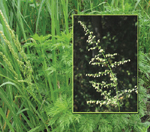 The leaves of Artemisia annua, the sweet wormwood tree, are the source
of the anti-malarial drug artemisinin, which is produced in small
quantities and requires an expensive extraction process. Keasling's
research, now with funding from the Gates Foundation, will make a
much more affordable anti-malarial drug avaialble.
The leaves of Artemisia annua, the sweet wormwood tree, are the source
of the anti-malarial drug artemisinin, which is produced in small
quantities and requires an expensive extraction process. Keasling's
research, now with funding from the Gates Foundation, will make a
much more affordable anti-malarial drug avaialble.
The aim of the Gates Foundation grant and the unique three-way partnership it will be supporting is to bring down the cost of treatment to well under a dollar.
Keasling’s research makes this goal possible through the use of E. coli bacteria that have been genetically engineered to quickly and cheaply synthesize a precursor to the chemical compound artemisinin. The idea is to use the modified bacteria as microbial drug factories that will one day replace the high cost and ecological problems of extracting artemisinin from the wormwood plant.
Says Keasling, “By inserting genes from three separate organisms into the E. coli, we’ve created a bacterial strain that can produce the artemisinin precursor, amorphadiene. We’re now in the process of cloning the remaining genes needed for the E. coli to produce artemisinin.”
To ensure that the final anti-malarial drug is affordable, even to the world’s poorest people, UC Berkeley has issued a royalty-free license to Amyris, which will produce the drugs at cost after One World Health has obtained FDA approval. It is Keasling’s hope that the nonprofit nature of this partnership becomes a model for attacking other neglected diseases in the developing world.
“This project will use some of the latest advances in molecular biology to engineer a microbial chemical factory and reduce the cost of a much-needed drug tenfold,” he says. “In many ways, this project is a dream project: interesting science, high technology, rapid transition from the bench to the bedside, and most important, critical need.”
Year in Review at Berkeley Lab
Great Science and Surprises Galore in 2004
If you blinked during 2004, you’re sure to have missed a hot topic of gossip and conversation. From a changing of the guard in Lab management, to scientific discoveries trumpeted around the world, to the latest pesky computer virus, something was abuzz at Berkeley Lab at all times. We learned that nothing could be taken for granted — not even the Lab’s seemingly-perpetual contract with UC. Nor even the Lab’s own taco salad, the recipe of which was changed — and then changed back. Even the familiar hillside changed, as buildings went down and others started to take shape.


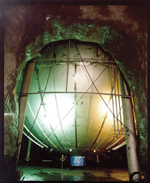
For science at Berkeley Lab this was another banner year. Lab researchers gave new hope to victims of AIDS, breast cancer, malaria, and Parkinson’s. They led the ongoing nanorevolution by peering into the world of the ultra small and designing machines 50,000 smaller than the width of a human hair. They expanded our understanding of faraway galaxies and of the properties of most elusive subatomic particles. They developed energy efficient materials and sequenced key human chromosomes.
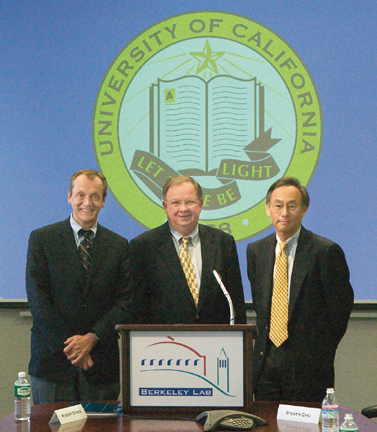 The announcement of Steve Chu’s appointment as the new Berkeley
Lab director was made at a June 17 press conference which also included
UC President Robert Dynes (left) and former Lab Director Charles Shank.
The announcement of Steve Chu’s appointment as the new Berkeley
Lab director was made at a June 17 press conference which also included
UC President Robert Dynes (left) and former Lab Director Charles Shank.
While these and endless others wonders of scientific ingenuity made headlines and won prestigious awards, none captured the imagination of the media like the work of two Lab researchers who applied technology used to study subatomic particles to reviving treasured voices from the past. Physicists Vitaliy Fadeyev and Carl Haber found a way to digitize century-old recordings believed to be unplayable, and as a result, some 500,000 music and spoken word recordings in the collection of the Library of Congress may spring back to life. The story had legs. From ABC News and the New York Times to newspapers around the world, everyone foresaw a day when we may listen to the voice of Thomas Edison or Queen Victoria — or even shed new light on the JFK assassination.
While all this wondrous science was being conducted, Berkeley Lab’s management underwent major transitions. It was early in the year that Charles Shank announced that after 15 years as head of Berkeley Lab he would step down. The suspense about who would pick up the baton of leadership ended in July with the announcement that Stanford Nobel Laureate Steve Chu would become Berkeley Lab’s sixth director. Chu won the 1997 Nobel Prize in physics for developing methods to cool and trap atoms with laser light.
Shank’s departure and Chu’s appointment were not the only surprises in store for Lab management. Last month, Sally Benson, the Lab’s deputy director for Operations, announced she would return to full research in February. And rounding up this eventful year was the news that Deputy Director Pier Oddone — with Berkeley Lab for 30 years — will leave next summer to head the Fermi National Laboratory (Fermilab) near Chicago.
Yet the most surprising news of the year may have been the announ-cement that for the first time since the U.S. national laboratory system was created more than 50 years ago, the contracts to operate the three national labs managed by the University of California would be put out for bids. The announcement jolted Lab employees, particularly the scientists involved in research collaborations, and joint appointments with the University.
UC is bidding for all three contracts. Could the Lab’s partnership with UC really end? Unlikely, but not impossible. Said UC President Robert Dynes, reassuringly, “We have a long tradition of scientific and engineering excellence at Berkeley Lab, and we are tremendously proud of the Lab’s groundbreaking achievements.”
Many of these achievements were recognized with prestigious awards won by Lab scientists almost every week of the year. Among those honored was chemist Richard Saykally, one of seven winners of the E.O. Lawrence Award — the highest given by the DOE — for his groundbreaking developments in the field of spectroscopy; Pier Oddone, who won APS’ prestigious Panofsky Prize; and Paul Alivisatos and Phil Colella, newly elected to the National Academy of Sciences.

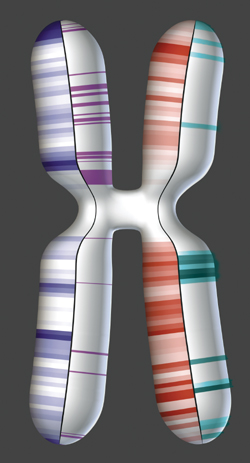
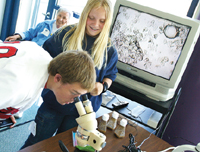
Scientists at Berkeley Lab broke new ground in 2004 — figuratively and literally. January 30 marked the official groundbreaking for the $85 million Molecular Foundry, which will herald a new era in nanoscience research. The facility, now rising on the hillside next to NCEM, is expected to be completed in 2006.
For everything that goes up, something usually comes down. Piece by piece, the External Proton Beam hall next to the now-decommissioned Bevatron was dismantled this spring, opening up landscape on Cyclotron Road that had been obscured by the structure since 1967.
Scientists at the 88-Inch Cyclotron, which had ceased to be a DOE user facility in October 2003, breathed a sigh of relief in January when the cyclotron was given a new lease on life. And science done there since is testimony to the facility’s value to the Lab and the world of science. Back in May, for instance, the VENUS ion source broke new records by confining a plasma at 28 gigahertz. Cyclotron Director Claude Lyneis said VENUS is “the highest-field operating ion source in the world, years ahead of the competition.”
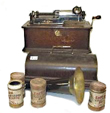 Recordings made on antiquated devices such as this phonograph are
now being brought back to life thanks to a technique developed by
two Lab physicists.
Recordings made on antiquated devices such as this phonograph are
now being brought back to life thanks to a technique developed by
two Lab physicists.
In life sciences, synthetic biology was especially big this year. Researchers at Berkeley Lab, led by Jay Keasling, are hoping to stem the scourge of malaria with a potent and affordable new drug developed by engineering bacteria. Just this week, the Bill & Melinda Gates Foundation awarded a $42.6 million grant to the Synthetic Biology Department to take the discovery to production level (see lead story). Keasling’s research may also help the fight against AIDS by tapping into the therapeutic potential of a compound found in the mamala tree in Samoa to cheaply synthesize the anti-AIDS drug prostratin.
In other life sciences developments, a team of scientists at Berkeley Lab and UC San Francisco have announced that the occurrence of an important event in the development of breast cancer — known as the telomere crisis — can be identified with precision. And Lab researchers have developed a way to use PET scans to track the effectiveness of a new gene therapy that promises to help patients with severe Parkinson’s disease.
The year also brought a breakthrough in laser wakefield technology. In theory, laser-wakefield accelerators could reach, in just a few score meters, the high energies attained by miles-long conventional machines. The L’OASIS group in AFRD, led by Wim Leemans, achieved the highest-quality beams yet — and provided Nature magazine with a cover story.
The Nearby Supernova Factory (SNfactory) marked another landmark when SNIFS, the Supernova Integral Field Spectrograph, achieved “first light” on June 8. Mounted on University of Hawaii’s 2.2-meter telescope atop Mauna Kea, SNIFS locked on to its first astronomical target — a Type Ia supernova in the constellation Cygnus. And this fall, the Gordon and Betty Moore Foundation awarded a $2.38-million grant to the SNfactory to further dark energy research.
An international collaboration of scientists, including a group at Berkeley Lab, reported the most precise measurements yet for the mass of the top quark, which requires an upward revision in the mass of the Higgs boson, and in turn has implication for the Standard Model of Particles and Fields. And scientists at the KamLAND neutrino detector in Japan have provided further evidence that the three known types neutrinos have mass and can change from one type to another.
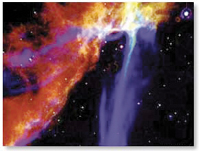
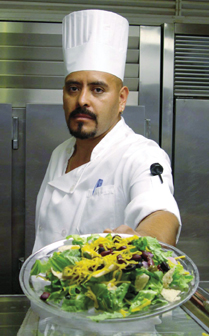
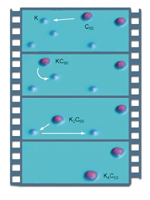
In materials sciences, a team led by Michael Crommie used a scanning tunneling microscope to attach individual potassium atoms to isolated carbon-60 molecules — soccer-ball-shaped “buckyballs” — to increase the electric charge on each C60 molecule. The doping of materials has applications for the entire modern electronics industry.
Advances in nanomaterials have come at a rapid clip from Paul Alivisatos’s laboratory this year, including the discovery that crystals of only a few thousand atoms can be turned into hollow spheres capable of trapping even smaller particles like catalysts inside. Researchers extended the technique to modify and tailor the electronic properties of nanocrystals. And working with the Scientific Computing Group, they found new ways to build segmented nanorods, calculate their electronic properties, and independently tune the separate components with unprecedented accuracy.
And in a development that brings the promise of mass production to nano-scale devices, Lab scientists have transformed carbon nanotubes into conveyor belts capable of ferrying atom-sized particles to microscopic worksites.
Window technology innovations went over big: Tom Richardson and Jonathan Slack won the Lab an R&D 100 Award for the transition-metal switchable mirror, whose glass coating can shift back and forth from transparent to almost completely reflective, making it energy efficient and economical. (The Lab also won a second R&D 100 Award for Alex Zettl’s rotational nanomotor — the smallest synthetic motor ever created, an achievement announced in 2003.)
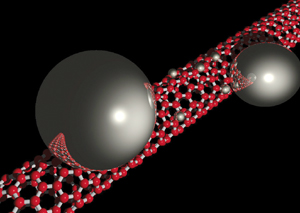
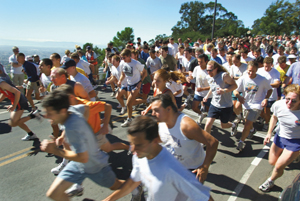
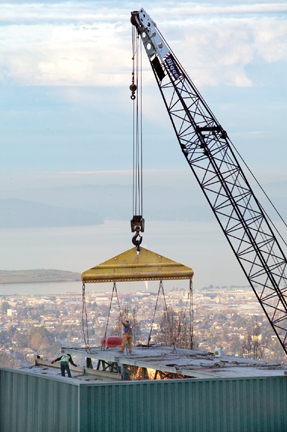
Out in Walnut Creek, scientists at the Joint Genome Institute (JGI) have reached genomic milestones after milestone in 2004. Among these is the complete sequencing of Chromosome 19, the most gene-rich of all the human chromosomes, with genes that code for diseases ranging from diabetes to migraines; and Chromosome 5, the largest human chromosome, which can provide a wealth of information about how humans evolved.
In January the JGI launched the Community Sequencing Program, providing valuable sequencing resources for many disciplines on the leading edge of science. Since then scientists there have sequenced a variety of microorganisms, such as the one causing devastating plant diseases like Sudden Oak Death — thereby promising to find ways to thwart such infestations.
And while most of these and so many other scientific achievements were accomplished using the most powerful and expensive tools of modern science, Ashok Gadgil demonstrated once again that ingenuity doesn’t always require state of the art equipment. All he needs to possibly save millions of lives may be a handful of ash. By coating it with a compound that attracts arsenic, Gadgil hopes to decontaminate water using tea-bag-sized filters in areas such a Bangladesh.
Amazing? As Director Chu said when he accepted his Nobel Prize, “It’s remarkable what simple curiosity can lead to.” Berkeley Lab scientists provided plenty of proof of that in 2004.
Annual Party Full of Holiday Cheer
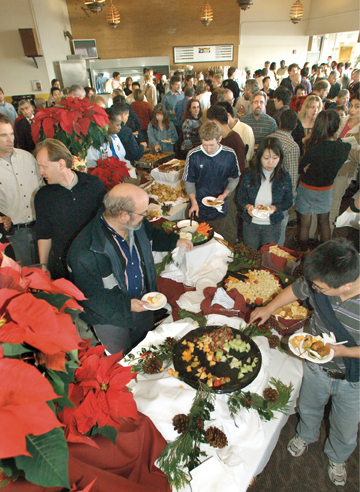 Hundreds crowded the festively-decorated cafeteria on Wednesday afternoon for the Lab's annual holiday party, one of the best-attended events of the year -- complete with seasonal music, plenty of food and refreshments, plus lots of holiday spirit and good company. Lab Director Steve Chu made a few brief remarks and introduced his wife Jean.
Hundreds crowded the festively-decorated cafeteria on Wednesday afternoon for the Lab's annual holiday party, one of the best-attended events of the year -- complete with seasonal music, plenty of food and refreshments, plus lots of holiday spirit and good company. Lab Director Steve Chu made a few brief remarks and introduced his wife Jean.
‘Ultraman’ Pushes Physical Limits for Fun
Lon Freeman suffered not one blister or pulled muscle as he swam, pedaled, and ran his way around Hawaii's Big Island
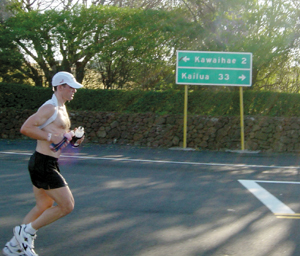 Freeman is just 33 miles from his next pit stop during the double-marathon
stage of the grueling Ultraman Race in Hawaii.
Freeman is just 33 miles from his next pit stop during the double-marathon
stage of the grueling Ultraman Race in Hawaii.
If Lon Freeman, an analyst in the Lab’s Budget Office, had a theme song, it would probably be Bruce Springsteen’s “Born to Run.”
The Hawaii Five-O ditty might also work. This is the tune that frequently ran through his head as he participated in the Ultraman Race, one of the world’s most physically grueling competitions, which took place late last month.
To get a sense of how challenging this contest really is, consider this: the three-day, 320-mile course around the perimeter of Hawaii’s Big Island consists of a 6.2-mile swim and 90-mile bike ride on day one, a 172-mile bike ride on the second day, and a double marathon, or 52.4-mile run, on the third.
A veteran of numerous Ironman triathlons, Freeman was looking for a different kind of challenge, so entered this year’s Ultraman race. Twenty-five people started the race and 18 finished. The lean and bright-eyed Freeman, who was 29 when he ran the race, not only finished, but came in third.
“I far exceeded my expectations,” he said. “I was fortunate to not have any mechanical or physical problems, and my crew of four really helped me get through quickly.”
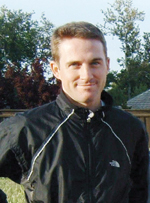
While he says his swimming skills are nothing to brag about, his running ability helped him gain an edge. On the third day, he ran the first half of the double marathon in just three hours; and the second half took only 38 minutes longer than the first.
And what did Freeman receive for all his hard work? “Everyone, including the winner, got the same thing … a plaque and a t-shirt,” he said.
Freeman was an active youngster, running track and playing football in high school. He got hooked on marathons in college and, since graduating, has competed in 11 Ironman races.
“I kind of soured on the Ironman competitions,” Freeman said. “There’s a lot of prize money involved and sometimes the races can be very cut-throat. That’s why the Ultraman appealed to me.”
Freeman is now branching out to trail running and will be competing in four different 100-mile races this summer in California, Vermont, Colorado, and Utah.
“I like the physical challenge,” says Freeman of his
desire to run long distances. “First I ask myself if it can
be done, then I figure out how I can do it.”
Getting Tough with Ceramics
Advanced ceramics withstand temperatures that would melt steel and resist most corrosive chemicals. If only they weren’t so brittle! Poor resistance to fracture damage has hampered the widespread use of advanced ceramics as structural materials. Help, however, may be on the way.
A study led by Berkeley Lab researchers has uncovered clues at the atomic level that could lead to a new generation of much tougher advanced ceramics.
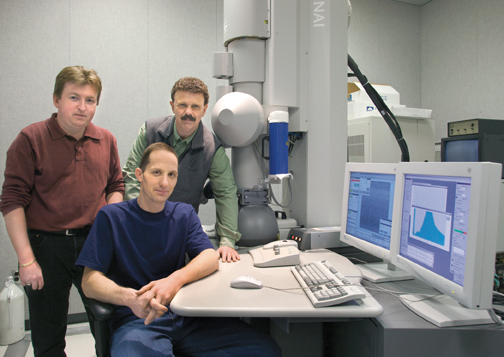
From left, Berkeley Lab scientists Nigel Browning, Alexander Ziegler
(seated) and Robert Ritchie used this Scanning Transmission Electron
Micro-scope to find new ways to toughen up advanced ceramics.
Working with the unique facilities at the National Center for Electron Microscopy (NCEM), the researchers have produced atomic-resolution images of silicon nitride ceramics that were sintered with oxides of rare earth elements to toughen them up and prevent cracks from spreading. These images revealed, for the first time, the exact location of each rare-earth atom in the final material and how their presence affected its toughness.
“Our findings are a prime factor in understanding the origin of the mechanical properties in advanced ceramics and should make it possible to do the precise tailoring in the future that will critically improve the performances of these materials over a wide range of applications,” says Robert Ritchie, a materials scientist who holds a joint appointment with Berkeley Lab’s Materials Sciences Division (MSD) and UC Berkeley.
Ritchie and Alexander Ziegler, a member of Ritchie’s research group, were the principal authors of a paper which appears in the Dec. 3, 2004 issue of Science. The other co-authors are Christian Kisielowski and Nigel Browning of Berkeley Lab, plus Juan Idrobo of UC Davis and Michael Cinibulk of the Air Force Research Laboratory in Ohio.
NCEM houses a Scanning Transmission Electron Microscope (STEM) which is optimized for materials applications that require the highest resolutions for both imaging and spectroscopy. With the help of NCEM staff members Kisielowski and Browning, Ritchie, Ziegler and the other materials scientists in their collaboration used this microscope in combination with an imaging technique called “high-angle annular dark-field STEM” and a chemical analysis technique called electron-energy-loss-spectroscopy (EELS) to examine a silicon nitride ceramic doped with several different rare-earth elements. They specifically looked at how atomic bonding configurations changed with a change in the rare earth sintering additive.
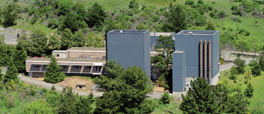
The
National Center for Electron Microscopy houses several of the world’s
most advanced microscopes and tools for microcharacterization.
“We were able to determine the exact location of each rare-earth atom and to see how these atoms specifically bonded to the interface between the intergranular phase and the matrix grains of the ceramic,” Ritchie says. “We saw that each rare-earth element attaches to the interface differently, depending on its atomic size, electronic configuration, and the presence of oxygen atoms along the interface. This information can be related to the fracture toughness of the ceramic.”
Ritchie and Ziegler say their results with the silicon nitride ceramic
and the rare earth elements should be applicable to other types of
advanced ceramics as well.
No Surprises in FY 2005 Budget
While no big fiscal changes are in store for Berkeley Lab’s projected Fiscal Year 2005 budget, some programs will see modest increases next year as a result of the latest Congressional action, which appropriated funds above those requested by the Admin-istration in a number of key areas.
On December 8, the President signed into law a consolidated appropriation bill to fund much of the federal government for FY 2005, including the U.S. Department of Energy. Even in a very tight budget year, this omnibus spending package provided an increase to the DOE’s civilian research and development programs. Consequently, Berkeley Lab should expect close to level funding in FY 2005 compared to FY 2004.
The Department of Energy’s Office of Science, which funds Berkeley Lab, did very well, with $3.3 billion for its research and development programs, a 4.3 percent increase over last year. Programs in high energy physics, fusion research, nuclear physics, computing research, and basic energy sciences all received modest increases.
Some Office of Science programs received appropriations from Congress above and beyond what the President asked for in his annual budget proposal. Much of the $152 million over the President’s request that the Congress provided will go toward increasing research grants and user time at national user facilities such as the Advanced Light Source and the National Center for Electron Microscopy here at Berkeley Lab. The Office of Science’s largest program account, Basic Energy Science, received an increase of $96 million — much of which will go toward supporting users at existing facilities.
The Molecular Foundry, a nano-science national user facility under construction at Berkeley, received the $32 million requested by the administration. This funding keeps the Foundry construction project on schedule for completion in 2006.
The Office of Science’s Advanced Scientific Computing program received an additional $30 million above the President’s request to assist the Department’s Leadership Class Computing initiative. This 14.9 percent increase brings the Advanced Computing budget to $232 million. These additional funds could potentially benefit computing research programs at Berkeley Lab, including the National Energy Research Scientific Comp-uting Center (NERSC), as the DOE attempts to strengthen the United States’ computing capabilities.
Although not direct funding, the final legislative report, otherwise called the Statement of Managers, included language directing the DOE to move forward on the Dark Energy Mission. This program is rooted in Berkeley Lab’s Supernova Cosmology Project and its proposed satellite, the Supernova Acceleration Probe (SNAP). The report language should be helpful in moving this critical scientific program forward.
Overall, federal investment in research and development reached new levels at $132.2 billion — a $6 billion, or 4.8 percent increase, over FY 2004. Civilian research and development funding was increased by $1.2 billion, or 2.2 percent, to $57.2 billion. Overall domestic federal expenditures were held to a 1 percent increase or lower.
Don Medley is Berkeley Lab’s manager of government affairs and community relations.
Lab Family Mourns Loss of Three
Dick Dicely: A Problem Solver, a Confidant, a Friend
When you look at the Oakland Scientific Facility, home of the National Energy Research Scientific Computing Center, or the administrative Building 937 in downtown Berkeley, or the soon-to-open Potter Street bioscience center in west Berkeley, think of Dick Dicely. They are but a few of the legacies left by this quietly productive man, who, at age 60, departed the Lab and this world far too early.
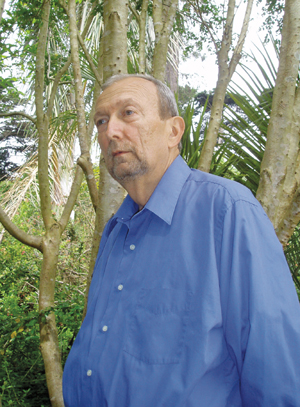
Last Sunday, Dicely lost a short fight against a pneumonia that ravaged his body. Just two weeks earlier, he was in his office, wrestling with space planning issues that have become the hallmark of this land-locked yet growing scientific facility.
“Dick was someone who worked quietly without being in the limelight,” said colleague and former supervisor David McGraw of Business Services. “He was a person who could find the best solutions to problems and issues that didn’t seem to have any.”
When NERSC outgrew its first home in Building 50, Dicely headed the team that eventually found the Oakland site, working through complicated leases, upgrades, shifts of 750 workspaces, and financial arrangements — all in just six months. He was similarly instrumental in securing space for various operations offices downtown when hill-based space became unavailable. The Potter Street laboratories, which will be a valuable bridge to prospective new biological facilities on the main site, also boast the Dicely imprimatur.
“He was someone who touched all of us,” Deputy Director for Operations Sally Benson told her management staff at a meeting on Monday. “He was a real fixture at the Lab and an important member of our family.”
Dicely’s Berkeley Lab tenure began in 1991, when he was hired by then-AFRD Director Klaus Berkner to coordinate environment, health and safety activities for the division. Much of his time was devoted to clearing up all the shortcomings identified in the “Tiger Team” inspections. Five years later, he moved to Computing Sciences and assisted with the department’s exploding space needs as well as its EH&S requirements.
Finally, he was tabbed in 1998 by Laura Chen, leader of the Facilities Planning Group, to be a senior member of the Facilities Division’s planning section, with broad responsibilities for space management, the project “call” process, excess space, and other important programs.
“There was no one better suited to handle the impossible job of space planner here,” said Chen, who called him “my right hand, my confidant. He did [space planning] in a manner that benefited the overall Lab, but respected the individual divisional needs.”
“His expertise and knowledge of the Laboratory facilities was extensive, and he possessed a phenomenal ability to recall even the most obscure details of moves and projects that occurred years ago,” wrote Facilities Director George Reyes to his staff. “In carrying out his duties over the years, there were no strangers to Dick, and he referred to almost everyone in the Laboratory community by their first name. He was the consummate Berkeley Lab employee; always there when you needed him, and always ready with a solution to the toughest problems.”
Joyce, his wife of 38 years, said they had just returned on Nov. 29 from an eight-day cruise to Mexico when her husband began experiencing the symptoms that eventually led to his death. In a note to friends last weekend, she pointed out, “We’ve had so much support from so many sources. Laura (Chen) and his friends at the Lab were at my side immediately.”
“We have not only lost a good friend,” Reyes said, “but the Lab has also lost an irreplaceable resource. We will all miss him more than words can express.”
The Dicely family has asked that donations may be made in Dick Dicely’s name to St. Vincent de Paul or the Benicia Community Action Council.
An obituary prepared by the family can be read in the December 14 edition of “Today at Berkeley Lab.”
William Holley, Pioneering Radiation Biologist
William R. Holley, a member of the Life Sciences Division and a physicist who pioneered uses of radiation to study biological systems, died November 19 at Berkeley’s Alta Bates Hospital after a two-year battle with cancer. He was 69.
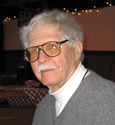
Born in 1935 in Matador, Texas, Holley was a child when his parents and two older brothers fled the Dust Bowl of the Texas Panhandle. The family had to earn their passage to California by picking cotton and lettuce. But when World War II brought an end to the Depression, Holley’s father, mother, and brother Bob found work in the Kaiser shipyards in Richmond, and after the war the family settled on a farm in Tulare County.
Holley was a star athlete who graduated from Visalia Union High School with honors in 1953, then spent two years at Visalia’s College of the Sequoias before winning a full scholarship to UC Berkeley. A Phi Beta Kappa, he earned his B.S. and Ph.D. in physics at UC Berkeley. Then he was off to the Rutherford Laboratory in England and subsequently to CERN, the European Laboratory for Particle Physics near Geneva, Switzerland.
In 1962 Holley married Dawn Laine of San Francisco; the couple had two sons, Gregory and Derek. In 1970 Holley joined Berkeley Lab and remained here until his death.
Inside the laboratory, Holley was a brilliant experimentalist and theorist who applied his knowledge of physics to biology. In the Life Sciences Division’s Theoretical Modeling program he modeled the structure of DNA and the organization of the chromosomes inside the cell nucleus. Outside the lab he remained an avid athelete and outdoorsman and eventually hiked the entire length of the John Muir Trail.
Aloke Chatterjee, a close friend and colleague, says Holley had many friends who will remember him “for his simple living and high thinking.”
Holley is survived by his wife, sons, brother Bob, and numerous nieces and nephews. A celebration of his life was held on December 12 at the Brazilian Room in Tilden Park. Those who wish to remember Holley are invited to contribute in his name to the Gregersen-Cecchi Cancer Fund, c/o Alta Bates Summit Foundation, 2450 Ashby Avenue, Berkeley, CA 94705.
Roger Dwinell, Valued Member of the 88-Inch Cyclotron Team
Roger Dwinell, a member of Engine-ering Division and head of the electronics group at the 88 Inch Cyclotron, has died, following a 20-year fight against cancer. Dwinell, 65, passed away in his home in Martinez on Saturday, December 11, surrounded by his family. He has been a member of the Berkeley Lab staff for more than 38 years.
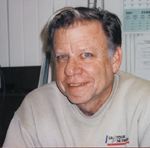
“Roger was highly regarded by everyone at the 88 Inch Cyclotron, and was a very effective group leader who was very much appreciated by the members of the electronics group,” said Claude Lyneis, program head of the 88 Inch Cyclotron and a long-time colleague of Dwinell’s. “In addition to his contributions to nuclear science, he also played an important role in developing the careers and capabilities of the younger staff.”
Dwinell was born in San Francisco on May 27, 1939. The son of an Army sergeant, his childhood was spent in various locales around the globe. He joined the Navy in 1957, and was still in the service in 1966 when he first came to the Laboratory as a part-time technician, working the swing shift of the Electronic Maintenance Group at the Bevatron.
In 1967, Dwinell left the Navy and began working full-time for the Laboratory. While at the Bevatron, he earned both a bachelor’s and a master’s degree in engineering from UC Berkeley. In 1976 he became one of the original members of the Real Time Systems Group. When the Bevatron closed in 1993, he was assigned to the 88 Inch Cyclotron. There, he played a prominent role as lead electrical engineer in a number of projects, including VENUS, the Versatile ECR ion source for Nuclear Science.
“Roger was an amazing person, one of these guys who had a lot of patience with people and equipment,” said Gudrun Kleist, another long-time colleague of Dwinell’s. “Even during his long struggle with cancer, he never lost his smile, he always remained upbeat and positive.”
Dwinell is survived by his wife of 43 years, Carole, daughters Laurie
and Beth, son, Michael, and four grandchildren (plus a fifth due in
January). A memorial service will be held on Saturday, January 8,
2005 at 4 pm, on Treasure Island at the old Officers’ Club,
which is now known as La Casa de la Vista.
Whirlwind Energy Efficiency Tour Visits Berkeley Lab
On the morning December 2, three days into a whirlwind tour of the nation’s leading institutions devoted to improving energy efficiency, about 25 Congressional staffers, administration officials, and corporate representatives rode a bus from Sacramento to Berkeley Lab.
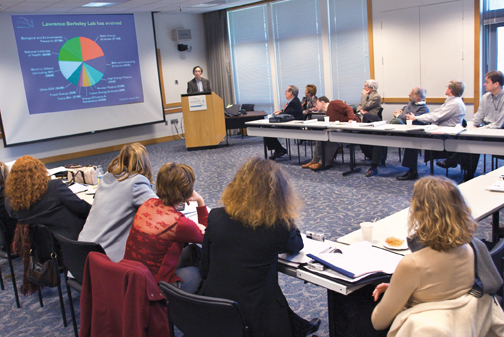 Director Steve Chu (at the podium) addresses the Congressional staff
delegation during its visit of Berkeley Lab.
Director Steve Chu (at the podium) addresses the Congressional staff
delegation during its visit of Berkeley Lab.
Their fact-finding trip had already taken them to the New York State Energy Research and Development Authority, the California Environ-mental Protection Agency, and the California Fuel Cell Partnership, among other places. With PG&E’s Pacific Energy Center scheduled for the next day, the group carved out several hours from their rushed schedule to learn about Berkeley Lab’s energy research. They were welcomed by Director Steve Chu, who underscored the importance of finding CO2-neutral energy sources before carbon-based fuels run out.
“Getting CO2-neutral energy is not even at the top of the nation’s priorities, but if we don’t do this in 30 years, life as we know it will change,” Chu said. “The priority of this work should be up there with national security and disease.” He added that progress will likely occur in multidisciplinary institutions such as Berkeley Lab.
“One of the reasons I took this job is I believe we have all of the pieces in principle here to look at this problem,” Chu said. “More and more people are being energized here at the Lab.”
Before listening to Chu speak, the group sampled Berkley Lab’s energy efficiency research with a quick demonstration of electro-chromic windows by Eleanor Lee, a scientist in the Environmental Energy Technologies Division (EETD) and project manager of the Advanced Windows Test Facility. They also toured the battery testing lab, guided by Frank McLarnon, manager of the Batteries for Advan-ced Transportation Technologies Program.
After Chu’s welcome, EETD Director Mark Levine provided an overview of energy efficiency research at Berkeley Lab. Next, William Fisk, head of the Indoor Environment Department, discussed the role and significance of indoor air quality.
“We need an expanded indoor air quality research effort,” Fisk said. “It must be integrated within building science and energy research if it is to become a central issue in agencies such as DOE.”
Jim McMahon, head of the Energy Analysis Department, discussed the energy and water connection.
“Energy requires water, and water requires energy,” McMahon said. “As much fresh water is withdrawn for producing electricity as for irrigation. And the treating and pumping of water requires three percent of annual U.S. electricity generation — more than petroleum refinement.”
The group’s Berkeley Lab visit ended with a talk by Don Grether,
head of the Advanced Energy Technologies Department, on the Lab’s
role in transportation sector energy technologies.
One Year Later, ASD Academy Is a Success
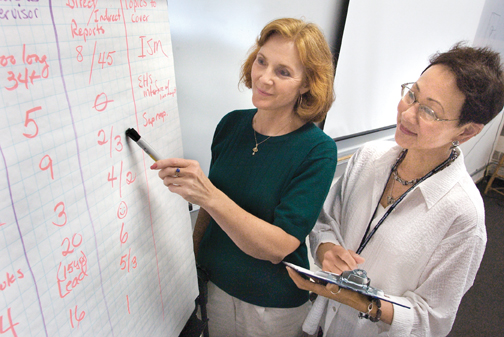
Helen
Wheeler (left) and Maki Tabata during an ASD Academy workshop.
More than one year after the Administrative Services Department (ASD) Academy opened its doors, a total of 1903 employees have taken 90 classes on such wide-ranging topics as coordinating travel, conference policies and procedures, and how to deliver a compelling business presentation.
“We feel like we are providing a vital service to ASD,” says ASD Academy administrator Sue Bowen. “But it’s more than just ASD employees — many people who take our courses are from other divisions.”
This mix of ASD and Lab employees enriches discussions in courses. The Academy, which opened in August 2003, gives Lab employees access to mentoring programs, online tutorials, soft-skills training seminars, and a resource and learning center that features a career development library, training videos, and a meeting room. Ultimately, the Academy serves the entire Lab by enabling employees to learn new skills, explore career options, and share their knowledge with others.
“The Academy was built on the idea that we have a lot of expertise in our own organization,” says Karen Ramorino, deputy of ASD and chief developer of the Academy. “Not only is it cost effective, but it makes sense to use in-house experts who know how the Lab works.”
In addition to providing teaching opportunities to everyone, Ramorino says the Academy also brings ASD members together, which is a big plus in a department with members matrixed across the Lab.
“The Academy has really helped build our community,” she says.
The Academy’s services are also expanding thanks to partnerships
with several UC Berkeley facilities. Through the University Health
Services’ Tang Center, the Academy offers classes on managing
stress, caring for elderly parents, and relaxation. Conflict resolution
courses are offered through the UC Ombudsman. And, most recently,
the Academy has teamed up with UC Berkeley Extension to provide classes
on business presentation skills.
Berkeley Lab View
Published every two weeks by the Communications Department for the employees and retirees of Berkeley Lab.
Reid Edwards, Public Affairs Department head
Ron Kolb, Communications Department head
EDITOR
Monica Friedlander, 495-2248, msfriedlander@lbl.gov
STAFF WRITERS
Lyn Hunter, 486-4698
Dan Krotz, 486-4019
Paul Preuss, 486-6249
Lynn Yarris, 486-5375
CONTRIBUTING WRITERS
Jon Bashor, 486-5849
Allan Chen, 486-4210
David Gilbert, 925-296-5643
FLEA MARKET
486-5771, fleamarket@lbl.gov
Design
Caitlin Youngquist, 486-4020
Creative Services Office
Communications Department
MS 65, One Cyclotron Road, Berkeley CA 94720
(510) 486-5771
Fax: (510) 486-6641
Berkeley Lab is managed by the University of California for the U.S. Department of Energy.
Online Version
The full text and photographs of each edition of The View, as well as the Currents archive going back to 1994, are published online on the Berkeley Lab website under “Publications” in the A-Z Index. The site allows users to do searches of past articles.
Flea Market
- AUTOS & SUPPLIES
- ‘96 LINCOLN CONTINENTAL town car, champagne color, sunrf, 4.5L V8, all pwr, heated leather seats, 3-way steering, thermostat temp control w/ ac, cruise, keyless entry, anti-theft syst, am/fm/cass, ABS, side air bags, couple small dents in trunk lid & driver side, rearview mirror need to be replaced, otherwise exc cond, new battery & alternator $6,500/bo, Nick, X6314
- HOUSING
- BERKELEY, furn rms, $850/mo incl all util, computer, DSL, kitchen, laundry, piano, nr shuttle/shops, Jin 845-5959, jin.young@juno.com
- BERKELEY, 1 bl to UC, lge, nicely furn 1 bdrm apt w/ computer & DSL, $1,575/mo incl all util, Jin, 845-5959, jin.young@ juno.com
- BERKELEY, nicely furn 1 bdrm, split level, sunny, safe, priv on quiet street in desirable resid Elmwood dist nr College/ Ashby, close to restaurants, shops, trans, walk to UCB, skylights, hill view from lge garden terrace, hi-fi/VCR/DVD, microwave, avail to one responsible, nonsmok visiting professional after Dec. 15, $850/mo, Agee, 843-1429
- BERKELEY, remodeled 3 bdrm/3bth top flr apt in quiet neighbhd, nr shops/rest/ BART/campus, new appliances, hardwd, tiles, closet space, spacious loft & hallway, sunlight, lge deck to backyard, w/d in garage, water, garbage incl, offstr parking, $2,700/mo+util, $2,000 sec dep, no pets/ smok, avail 3/1/2005, Vlad or Linda, 849-1579, lmoroz@earthlink.net.
- BERKELEY HILLS, fully furn rm w/ sep entry, full kitchen privil, w/d, quiet neighbhd, lovely backyard, next to bus stop, avail now, labartists@aol.com, 524-3851
- EL CERRITO HILLS, priv rm in shared house, $520 + expenses, lge rm w/ bay view, spacious common area incl lge liv rm, equip kitchen & laundry, pleasant backyard, Cinthia, 932-9186
- KENSINGTON, short term rentals for holiday season, furn 3 bdrm home, view, garden setting, furn rm with bth, Ruth: 526-6730, 526-2007
- NORTH BERKELEY, B&B, breakfast daily, lovely furn rms, $645/mo, avail immediately, Helen, 527-3252
- NORTH OAKLAND, quiet, cozy cottage w/ priv ent in backyard garden, cable ready, carpet, lge closets, eat-in kitchen, nr pub trans/BART, no smok/pets, 1-yr lease, $1,050/mo incl all util, dep $2,100, ref & credit check req, 654-2863 sr_hd@gteinternet.com
- OAKLAND/Lake Merritt, sublet 2/05-7/05, 2 bdrm/1 bth, fully furn, 2nd bdrm used for storage, incl covered parking, laundry rm, pool, water & garbage, close to BART/shops, $1,095/mo, Michelle, 325-8604 cell, mshld@yahoo.com
- TARA HILLS, 2 bdrms in 4 bdrm/2 bth house, share w/ a female, $550/mo, avail 1/1/05, Liz, X2724, 685-0005, Lbear2500@ aol.com
- WEST ORINDA, 1 bdrm apt in hills, woodsy area, lge deck, brick patio, w/d connections, $950+share util & high-sp cable, Jim, 925 831-9958, mtdo42@sbcglobal.net
- MISC ITEMS FOR SALE
- WALKER, 3-whls walker, hand brakes, pouch, exc cond, $75; shower chair w/ back support, adj height, good cond, $45, Ron, X4410, 276-8079
- SONY STEREO SYST, complete surround sound (2 fr /1 ctr/ 2 rear speakers), pristine cond, orig boxes & manuals, incl fm-am receiver, dual stereo cass deck, CD player, matching blk audio rack w/ glass doors, $400/bo, Mike, X8647, (925) 932-8647
- SCANNER, HP Flatbed 5300C w/ software, out of box, never used $75/bo, Barbara, X6875
- KITCHEN ISLAND, 1 drawer, 1 cabinet & 2 matching stools, exc cond, $150/bo; lge oval mirror, $15, Liz, X2724
- CHURCH PEW, solid oak, 5-1/2 ft long, curved back, carved side, padded seat, $650/bo, June, 704-8664
- AIRLINE VOUCHER, Southwest R/T, expires 11/16/05, $300; 2-seat sofa, green w/pink pattern, good cond, $85; futon w/ iron frame, good cond, $95; twin-sz mattress/box & frame, incl bed skirt & sheet, $95; floor lamp, misc other items, Minmin, 847-5130
- FREE
- BASKETBALL RACK, full size, complete set, Duo, X6878, 528-3408
- VACATION
- TAHOE Donner/Truckee for ski lease, 1/1/05-5/1/05, 3 bdrm/2 bth, sleeps 10-12, attached 2-car garage, driveway snow removal incl, $1,700 per/mo, Dale, X2791, 465-1298
- TAHOE KEYS, 3 bdrm/2.5 bth house, fenced yard, quiet sunny, skiing nearby, views, $195/night, 2 night min, Bob (925) 376-2211
- LAS VEGAS, time share, Polo Towers, 5 star, 2 bdrms, 1-wk every
other yr or 1 bdrm-1 wk every year, floating time, $17,000/neg,
Mustafa, 451-1350, X5081
Flea Market Policy
Ads are accepted only from Berkeley Lab employees, retirees, and onsite DOE personnel. Only items of your own personal property may be offered for sale.
Submissions must include name, affiliation, extension, and home phone. Ads must be submitted in writing (e-mail: fleamarket@lbl.gov, fax: X6641,) or mailed/ delivered to Bldg. 65. Email address are included only in housing ads.
Ads run one issue only unless resubmitted, and are repeated only as space permits. The submission deadline for the January 7 issue is Thursday, December 23.
Many Shared for SHARES
A big thank you to all who contributed to Berkeley Lab's annual community charitable giving campaign, SHARES, which officially ended on Dec. 3. According to the preliminary, unofficial tally, 152 donors contributed a total of $50,121. The campaign, now entering its seventh year, supports Berkeley Lab’s commitment to reach out to surrounding communities and help organizations that depend largely on donations. SHARES stands for Science for Health, Assistance, Resources, Education and Services.
To kick off the campaign, which started November 1, Berkeley Lab employees received packets in the mail that outlined the donation process and listed 13 local charities dedicated to science and education outreach. These include agencies that give struggling students a boost, such as Project SEED, which helps elementary and middle school children improve their math skills. Other charities expose children to the wonders of science and its job opportunities, such as Berkeley Biotechnology Education, Inc., which creates partnerships between industry and schools to teach students about careers in biotechnology.
Awards and Honors

Becker Receives Award from the Defense Department
Berkeley Lab earth scientist Alex Becker was one of the researchers recently lauded for their efforts in helping the Defense Department meet environmental challenges that impact military readiness. The awards were handed out during a symposium sponsored by the Strategic Environment Research Development Program and the Environmental Security Technology Certification Program. Becker was recognized for developing a multi-sensor system for the detection and characterization of unexploded ordnance. Lab colleague Frank Morrison accepted the award on Becker’s behalf.

Postdoctoral scientist Michael Commer (right), who works in the Earth Sciences Division, has been awarded the 2004 Klaus-Liebrecht-Preis by the University of Cologne, Germany. The award recognizes outstanding dissertation work at the University. Commer completed parts of his doctoral thesis on 3D large scale data inversion with the help of Lab scientist Gregory Newman (left). Both scientists have also received a Feodor Lynen Research Fellowship, which provides financial support to young German academics to pursue their research outside of Germany.